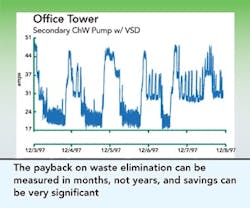HVAC Optimization for Energy Savings
Almost every building wastes 10 percent or more of the energy it consumes due to inefficient operation of the HVAC system. In many buildings, the inefficiencies were built in during construction and have become part of the baseline consumption numbers used to predict operating costs each year. In others, modifications made over time in response to complaints, or for providing a quick fix to an equipment problem, contribute to reduced performance. The reasons for the waste vary – the challenge is how to identify and eliminate them in an economical manner. Because the waste is “hidden” within the building systems, most energy strategies concentrate on equipment upgrades to address inefficiencies and lower energy costs. In some cases, this may be the proper strategy for the building – finding and eliminating the hidden waste may cost much more money than it will save. But, in many buildings (large or extremely intensive facilities), the simple payback on waste elimination can be measured in months, not years, and savings can be very significant.
Defining the Opportunity
First, define the opportunity. In this case, optimization refers to adjustments or minor mechanical fixes to existing equipment to make it operate as intended. You’re focusing on tuning the existing system for performance, and energy savings is a byproduct of optimal performance. This process of optimization involves a systematic collection of information from the building management system and facilities staff, and, most importantly, energy data collected from key pieces of equipment. This energy data often shows that what you think is happening in the building is not, in fact, correct. No matter how advanced the building management system is, these direct energy measurements will often uncover inconsistencies. There are no typical findings to point to, but control sequences, short-cycling of compressors, and unintended equipment operation are general categories in which inefficiencies are uncovered.
An example of unintended operation is shown at the top of the page – it’s a 100HP chilled water pump that was found ramping up in the middle of the night in December (the building was in the Northeast). This resulted from a temporary fix for a coil-freezing problem years before, and had simply become invisible, but the data monitoring quickly pointed it out.
Estimating the ROI
This process of optimization, while not capital-equipment focused, does involve a significant amount of labor and cost. How can you calculate your opportunity and get an estimate of the ROI for optimizing the system in your building? One of the best ways to estimate opportunity is to benchmark your building using the EPA’s Portfolio Manager. It collects and summarizes energy data and costs, and, for many types of buildings, will benchmark your building against other similar use buildings in your geographical area. Using the utility cost summary, you can use a figure of 10 percent as the baseline potential for the building (we’ve never seen less). That figure is now an estimate of your yearly savings potential from optimizing the HVAC system. If you hire an engineering firm to perform the optimization, you should estimate a cost of 22 cents per square foot to account for labor and hardware. Using this formula, if your building is 100,000 square feet and used a total of $300,000 in utilities in the past year, your potential savings would be $30,000 per year. The cost to get those savings? $22,000, with a simple payback of about 9 months.
In our experience, when energy savings are the only consideration, this type of service may not be attractive if the ROI is greater than 1 year. Beyond 12 months, this opportunity begins to compete with capital equipment upgrades. In office buildings, the formula above generally limits the service (using an outside firm) to buildings greater than 75,000 square feet; however, if you perform the service using in-house staff, you can lower the cost – but it’s often tough to free up time.
Optimizing your HVAC system for savings will save you energy. The key is to focus on a cost-effective strategy for getting to the savings, and choosing the opportunity wisely.
Michael Della Barba is the director of commissioning services at Environmental Health & Engineering (EH&E) in Needham, MA. Contact him at [email protected].
